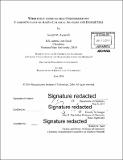Wirelessly addressable chemiresistors : carbon nanotube-based chemical sensors and dosimeters
Author(s)
Azzarelli, Joseph M. (Joseph Michael)
DownloadFull printable version (22.86Mb)
Other Contributors
Massachusetts Institute of Technology. Department of Chemistry.
Advisor
Timothy M. Swager.
Terms of use
Metadata
Show full item recordAbstract
In Chapter 1, we develop a brief tutorial on chemiresistive sensors and our rationale for choosing nanowires (NWs), specifically carbon nanotubes (CNTs), as the basis for chemiresistor research. Due to their high surface area, interwire junctions, and restricted conduction pathways, NWs give intrinsically high sensitivity and new mechanisms to transduce the binding or action of analytes. We explore principles for understanding electrical transport and transduction mechanisms in NW sensors. Next, we offer the reader a review of chemical sensor device performance parameters. Then, we summarize NW assembly and different device platform architectures. Subsequently, we discuss CNT functionalization strategies. Finally, we propose future developments in NW sensing to address selectivity, sensor drift, sensitivity, response analysis, and emerging applications. In Chapter 2, we describe a rapid, solvent-free, two-step procedure for the fabrication of selective gas and vapor sensors from carbon nanotubes and graphite on the surface of paper that overcomes challenges associated with solvent-assisted chemical functionalization and integration of these materials into devices. The first step generates solid composites from carbon nanotubes (or graphite) and small molecules (chosen to interact with specific types of gases and vapors) by mechanical mixing and subsequent compression into a form similar to a conventional pencil "lead." The second step uses mechanical abrasion ("drawing") of these solid composites on the surface of paper to generate functional devices. The use of diverse composites yields sensing arrays capable of detecting and differentiating gases and vapors at part-per-million concentrations. In Chapter 3, we describe an adaption of near-field communication (NFC) technology toward portable, wireless, non-line-of-sight gas phase chemical sensing. The result is a Chemically Actuated Resonant Device (CARD). We demonstrate the ability to convert inexpensive commercial NFC tags into chemical sensors that detect and discriminate analytes at part-per-thousand and part-per-million concentrations. This effort merges rational design of conductive nanostructured materials for selective chemical sensing with portable and widely distributed NFC technology to deliver a new method of acquiring chemical information about an NFC tag's local environment. We introduce a concept for distributed chemical sensing by the growing number of people that carry NFC-enabled smartphones, tablets, and other smart devices. We highlight second-generation NFC-based chemical sensor circuit designs that generalize turn-on/turn-off functionality. Finally, we devise a new Chemically Actuated Resonant Device (CARD) architecture that simplifies device fabrication to a single step and unambiguously relates change in chemiresistance to a wireless CARD readout. In Chapter 4, we describe a single-use wearable hazard badge that dosimetrically detects diethylchlorophosphate (DCP), a model organophosphorous cholinesterase inhibitor simulant. To provide selective and readily manufacturable sensor elements, we developed an ionic liquid-mediated single walled carbon nanotube based chemidosimetric scheme capable of detecting DCP across a broad dynamic range with limits of detection of 28 parts-per-billion (ppb). Furthermore, we have established a relationship between CARD readout and exposure dose, which can be generalized for any dosimeter developed with this device architecture. The device's practical utility is demonstrated wherein an 8-hour workday time weighted average equivalent exposure of 10 ppb DCP effects an irreversible change in smartphone readout. Finally, we show that the device is selective for DCP by screening against 8 commonly encountered interferent gases and vapors. In Chapter 5, we seek to develop an alkene dosimeter by exploiting known [4+2] cycloaddition chemistries. Specifically, di-substituted- 1,2,4,5-tetrazines are employed as a model inverse-electron demand Diels-Alder agent for the dosimetric detection of ethylene. Possible device architectures and fabrication strategies are explored, including colorimetric and chemiresistive implementations. A new solid/liquid chemiresistor fabrication method is demonstrated, and future directions for improving the sensitivity of diene-type alkene dosimeters are discussed.
Description
Thesis: Ph. D., Massachusetts Institute of Technology, Department of Chemistry, 2016. Cataloged from PDF version of thesis. Includes bibliographical references.
Date issued
2016Department
Massachusetts Institute of Technology. Department of ChemistryPublisher
Massachusetts Institute of Technology
Keywords
Chemistry.